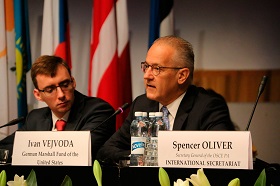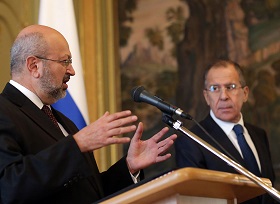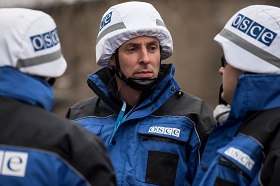In the 40 years since the signing of the Helsinki Final Act, the OSCE, which began as the Conference on Security and Co-operation in Europe (CSCE), has seen its fair share of ups and downs, both during and after the Cold War. The successes, which without a doubt include the signing of the Final Act in 1975 and the adoption of the Charter of Paris for a New Europe in 1990, have always alternated with difficult periods, where it sometimes seemed that the Conference’s / Organization’s resources had been exhausted and it had no future.
That is what happened immediately after the Summit in Helsinki – at the CSCE Follow-Up Meeting in Belgrade in 1977–1978 and again in Madrid in 1980–1983, when the Soviet leadership was on the verge of acknowledging that there would be no further meetings if the debate on human rights started in Belgrade were to continue. And it happened again in 1986, when Washington considered pulling out of the Helsinki Process, as it had not, in their opinion, brought the desired results (particularly with regard to human rights).
The recent history of the OSCE is similarly littered with periods of difficulty and disappointment. Nevertheless, every time someone in the West or the East has raised the question of whether we even need such an organization and, if we do, then why do we need it, the answer has always been in the affirmative, albeit after much deliberation and doubt. And the need for the OSCE has grown in direct proportion to the state of relations between East and West, becoming one of the last remaining platforms where political dialogue can be held, while others were folded up completely.
This is what happened in the early 1980s, when the USSR walked out of negotiations on the non-proliferation of nuclear weapons in response to the deployment of U.S. missiles in Europe, but “remained” part of the Stockholm Conference on Confidence- and Security-Building Measures and Disarmament in Europe convened in accordance with the relevant provisions of the concluding document of the Madrid Meeting of the Conference on Security and Cooperation in Europe, which began in 1983.
And we are seeing something similar happening today: against the background of the Ukrainian crisis and worsening relations between Russia and the West, the OSCE continues to be the only multilateral platform for taking collective decisions to resolve the crisis that is supported by all sides – Russia, Ukraine, the United States, the European Union and NATO.
Of course, the OSCE (the CSCE changed its name to the OSCE in 1995) has never been more vital to European politics than it was throughout practically the whole of the 1990s. Back then it seemed that, instead of a rupture, Europe was heading towards unification on the basis of a commitment to the common values enshrined in the Charter of Paris for a New Europe – democracy based on human rights, prosperity through economic freedom, and social justice and equal security for all. Common European structures and institutions, which today make up the backbone of the OSCE’s executive structures, began to take shape. The Organization was instrumental in the resolution of a number of armed conflicts, most notably in the former Yugoslavia, and helped bring about a political settlement to the Albanian Crisis in 1997 that threatened to rip the country in two.
The reasons for the OSCE losing much of its relevance within the European “security architecture” since the beginning of the new millennium are many, and it is almost impossible to single out one as the main cause.
The EU and NATO expansion that began in the late 1990s undoubtedly reduced the importance of the OSCE for its new members. But it is not so much the expansion, which resulted in more than half of the OSCE’s participating states being integrated into the Euro Atlantic structures. The organizations themselves changed, primarily the European Union, which, through the formation of the Common Foreign and Security Policy instruments, assimilated practically all the competences that had been the domain of the OSCE throughout the 1990s, including crisis management. As a result, since the turn of the millennium, the European Union has “replaced” the OSCE in terms of regulating conflicts in Southeast Europe (although not completely, as the Ukrainian crisis has proved).
Russian policy has changed in the face of Euro Atlantic expansion. Since the 1990s, its main focus has shifted from strengthening the OSCE to the institutionalization of a strategic partnership with the European Union and NATO, largely at the expense of the OSCE.
Since the beginning of the 2000s, there has been growing resistance, with mostly former Soviet states attempting (unsuccessfully) to shift the centre of the Organization’s activities to the post-Soviet space. The OSCE has entered a period of endless discussions on appropriate ways to reform the Organization. The last decade has seen a schism form within the OSCE, with new versions of East and West standing at either side of the divide. Recent attempts to drag the Organization out of this situation (Russian proposals for a European Security Treaty made at informal meetings of OSCE foreign ministers in 2008–2010; the “Corfu Process” in 2010; the 2010 OSCE Summit; and discussions in the Helsinki+40 framework) have not brought the desired results. And the Ukrainian crisis has virtually paralysed discussions on the possibility of improving the European security architecture, not only within the OSCE, but in other structures as well.
In times of difficulty in international relations, politicians love to point the finger at international organizations, accusing them of inactivity, sluggishness and dragging their feet when it comes to adapting to new realities. But international organizations are not sovereign entities of international relations. If they are unable to complete this or that project or carry out a certain initiative, it is usually not their fault, but rather the fault of participating states. During periods of crisis and mutual mistrust, the negotiability of states weakens, as does the operational capacity of international institutions created by them.
This general state of affairs can be applied to the OSCE. When deciding upon the formation and strengthening of common European executive structures, the OSCE participating states created “weak” structures from the outset, assigning them the role of carrying out their collective will. Provided there is a consensus within the organization, of course. The absence of a consensus paralyses the OSCE, denying it the chance to realize its potential, which is immeasurably greater than it was in 1990s.
Today, the OSCE is first and foremost an extensive regulatory framework that has been developed over the course of 40 years: principles enshrined in the Helsinki Final Act of 1975; other commitments made by participating states in various CSCE and OSCE documents; and concrete agreements that they have pledged to carry out.
Arguments and discussions about the (non-)implementation of these principles and commitments have taken place over the course of the organization’s history. And this does not diminish, but rather confirms, their abiding relevance.
This much is clear from the fact that the participating states continue to appeal to the principles and commitments enshrined in CSCE and OSCE documents over the years. Over the past decades, this regulatory framework has become an indispensable foundation of European security and cooperation. This foundation can be built up and “appended”. But abandoning the set of rules and offering something different is a task that is doomed to failure.
Secondly, the OSCE is a platform for political dialogue on the widest range of issues, primarily European security and cooperation. How individual states use these opportunities – for better or worse – is a question that should be addressed to the states themselves, rather than to the organization.
Finally, the OSCE has a wide range of tools at its disposal, not only for crisis management and conflict resolution, but also for carrying out other operational activities in three main areas: security (which includes conflict resolution), economic cooperation and environmental protection (the human dimension).
The organization possesses significant, and virtually untapped, potential in the search for joint answers to new cross-border security challenges – international terrorism, the safe use of information and communication technologies, fighting international organized crime, human trafficking, drug trafficking, etc. The extent to which governments use and improve OSCE tools in the relevant areas depends first of all on the governments themselves, since the absence of a consensus among OSCE members effectively paralyses the organization.
Today, against the backdrop of the Ukrainian crisis, the OSCE is experiencing yet another renaissance. The prospects for resolving the conflict in and around Ukraine are directly linked to the work of the OSCE, although the crisis management instruments available to the organization are measured out in strictly controlled doses by participating states.
How long will this renaissance last? If the participating states continue to adhere to the policy line of maintaining the status quo within the organization – and this is exactly what they are doing – and if they do not show a willingness to endow the OSCE with the status and powers of a fully fledged regional organization, or its “executive” structures with greater independence, then the current period of the OSCE’s increased activity will go down as yet another missed opportunity for strengthening the European institutions, while the organization itself can expect further marginalization in the system of European security and cooperation.








